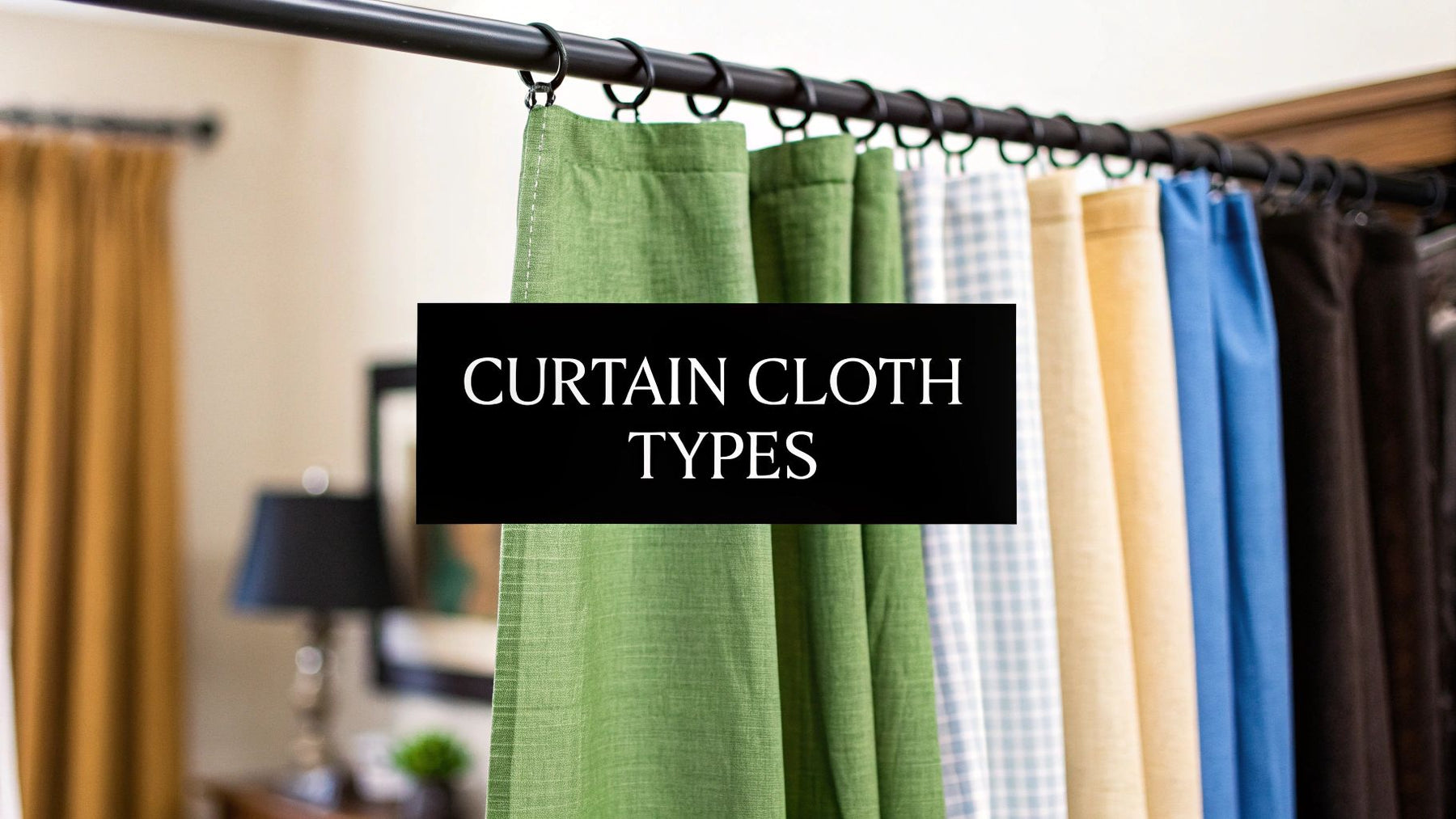
Guide to Curtain Cloth Types: From Sheer to Blackout
Choosing the right curtain cloth can feel like a huge decision, but it's simpler than you think. It boils down to two things: how you use the room and your personal style. For a dependable, everyday look that never fails, cotton is a classic. If you're aiming for drama and luxury, velvet is a fantastic choice for blocking light and adding a touch of elegance.
This guide will walk you through the most popular curtain cloth types so you can find the perfect match for every window in your home.
Table of Contents
- Why Your Curtain Fabric Choice Matters
- Natural Fabrics: The Timeless Appeal of Cotton & Linen
- Elegant Fabrics: The Luxurious Drape of Silk & Velvet
- Synthetic Fabrics: Durable & Practical Options
- How to Match Curtain Fabric to Each Room's Needs
- Caring for Your Curtains to Make Them Last
- Frequently Asked Questions About Curtain Cloth Types
Why Your Curtain Fabric Choice Matters
Picking the right material for your curtains is about much more than color or pattern. A fabric's weight, texture, and composition directly impact light control, privacy, energy efficiency, and the overall mood of your space. Think of it as casting a character for your room—are you going for light and airy, or cozy and dramatic?
The right curtain cloth can completely transform a room by:
- Controlling Natural Light: Sheer fabrics soften and diffuse sunlight, while heavier, opaque materials can block it out almost completely.
- Enhancing Privacy: Thicker weaves create a solid barrier, shielding your home from the outside world.
- Improving Insulation: Heavy fabrics can help keep rooms warmer in winter and cooler in summer, potentially saving you on energy bills.
- Defining the Style: The texture and the way a fabric hangs—its "drape"—play a huge role in a room's final look and feel.
According to a recent market analysis, polyester and cotton are the most popular curtain materials worldwide. Their dominance has a massive impact on the global curtain fabric market, which was valued at $12.3 billion in 2023 and is projected to continue growing.
This handy infographic breaks down the most common fabric families you'll come across.
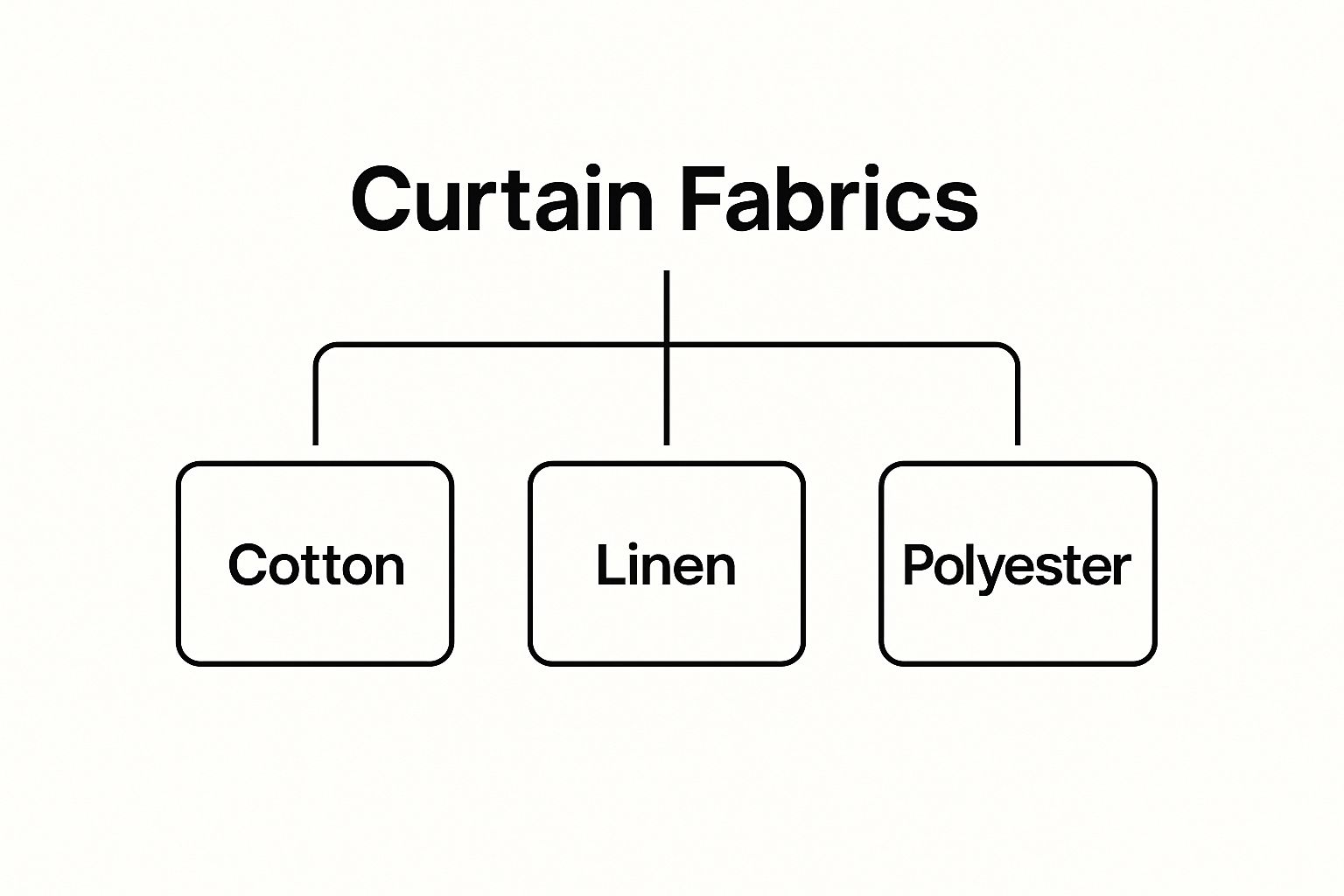
As you can see, foundational materials like cotton, linen, and polyester are the building blocks for most curtain options.
Of course, the fabric is just one piece of the puzzle. For a complete picture, understanding the key considerations when choosing windows and doors gives you a broader perspective on how everything works together to create a functional and beautiful home.
Natural Fabrics: The Timeless Appeal of Cotton & Linen
When you're after a timeless, versatile look, natural fibers like cotton and linen are likely the first that come to mind. Like a favorite pair of jeans or a crisp white shirt, they just work. These materials bring a sense of classic comfort to any space, making them the dependable workhorses of the fabric world.
Cotton offers a clean, fresh look that fits almost any decor style. Its soft texture and balanced weight mean it hangs beautifully, creating soft, gentle folds without feeling too heavy or formal. This makes it a fantastic choice for living rooms, kitchens, and casual bedrooms where you want a relaxed but put-together atmosphere.
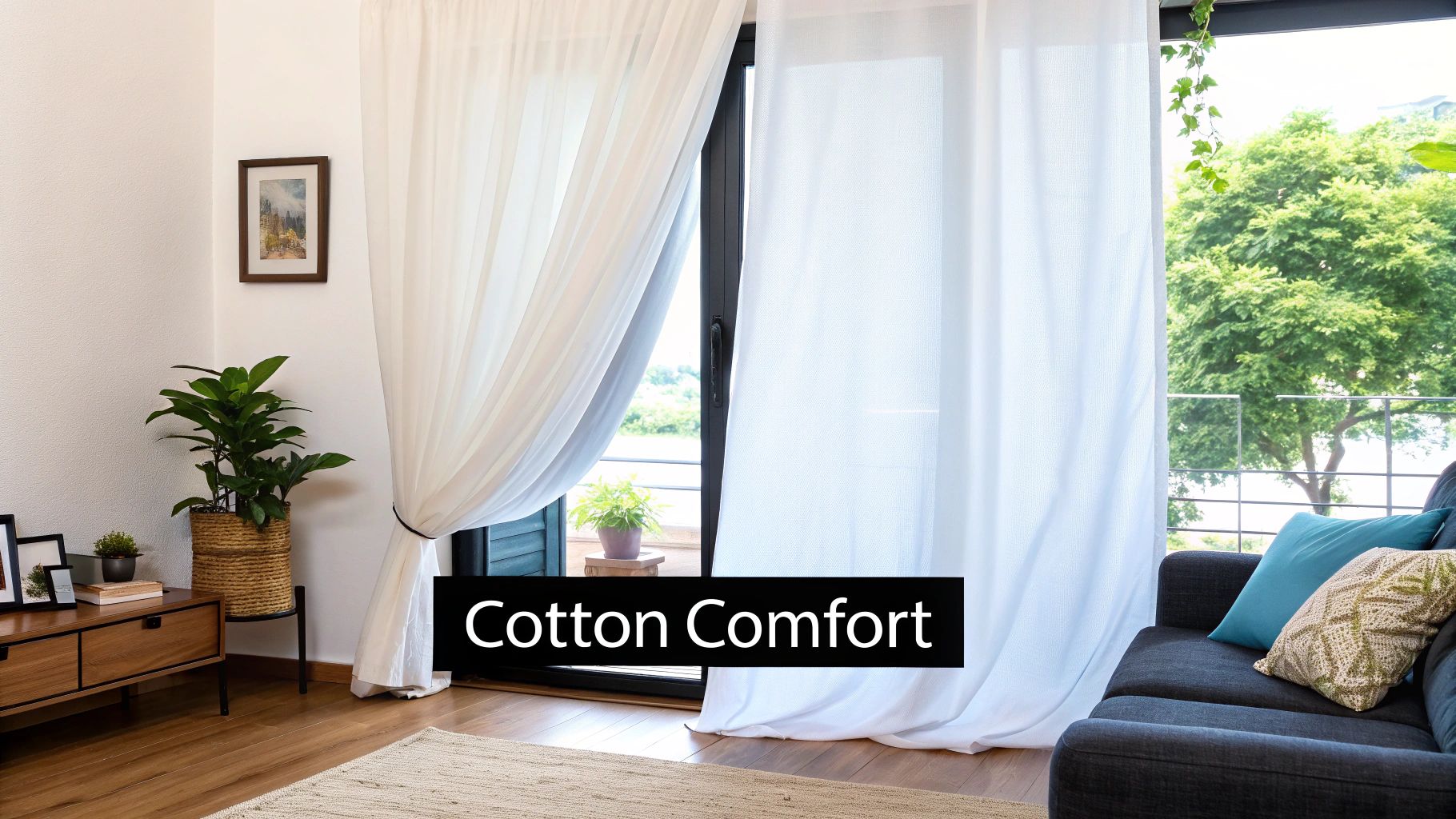
Cotton: The Versatile Classic
So, what makes cotton so popular? The short answer is its practical benefits. It's a breathable fabric that lets air circulate, and it’s generally easy to clean—many cotton curtains can be tossed in the washing machine, a huge plus for any busy household.
However, it’s not without its quirks. It's worth remembering that 100% cotton can be prone to wrinkling and may fade over time if it sits in direct sunlight day after day.
- Pros of Cotton: Breathable and soft, incredibly versatile for different decor styles, usually affordable, and often easy to clean at home.
- Cons of Cotton: Can wrinkle easily, may not be the best for damp environments due to mildew risk, and can fade or weaken with prolonged sun exposure.
For rooms that get intense sunlight, consider a cotton blend or adding a protective lining. It will go a long way in extending the life of your curtains.
Linen: Effortless, Airy Charm
Linen brings its own distinct personality to the table. It has a unique, slightly textured weave that gives it an airy, organic feel—perfect for a relaxed, coastal, or modern farmhouse vibe. Linen curtains drape beautifully and filter light in a soft, diffused way that adds warmth and character.
Because it's such a strong natural fiber, linen is exceptionally durable. With the right care, linen curtains can last for years, often getting softer and more beautiful with every wash.
Of course, linen is famous for its tendency to wrinkle, but many feel that’s just part of its casual charm. If you prefer a more polished look, be ready to do some regular steaming or ironing. Like cotton, it's also best to keep it out of damp areas like bathrooms to avoid mildew.
If you're interested in bringing more eco-friendly touches into your home, our guide to sustainable interior design materials has great ideas for creating a greener living space.
Elegant Fabrics: The Luxurious Drape of Silk & Velvet
When you want to bring drama and sophistication into a room, silk and velvet are the undisputed champions of elegance. These fabrics turn any window from a simple opening into a stunning focal point. They're all about making a deliberate, luxurious style statement.
Silk, for instance, has a delicate, shimmering luster that catches the light in a way no other fabric can. Its natural sheen creates a formal, refined atmosphere perfect for primary bedrooms or formal living rooms where you want a touch of romance and grandeur.
Silk: The Timeless Allure
Silk curtains are treasured for their beauty, but they are one of the more delicate curtain materials out there. They need extra attention to keep them looking their best.
- Benefits of Silk: It has a gorgeous, luminous sheen that adds instant luxury. The smooth texture and lightweight feel create an elegant, flowing drape that’s hard to beat.
- Considerations: Silk is very sensitive to sun damage, which can cause it to fade or even weaken over time. It’s also a fabric that's best left to professional dry cleaners to avoid water spots or shrinkage.
To protect your investment, always use a lining with silk curtains. A simple cotton or blackout lining does more than just add body—it acts as a shield, protecting the delicate silk fibers from harsh UV rays.
Velvet: The Rich, Plush Choice
Velvet is all about rich, plush texture and incredible depth. Its dense, heavy weave makes it a fantastic insulator, great for blocking chilly drafts and muffling outside noise. For a truly opulent feel, fabrics like silk and velvet fabric are simply unparalleled.
Because it's so heavy and thick, velvet is also one of the best materials for blocking light. This makes it an ideal choice for a formal dining room, a media room, or a bedroom you want to feel like a sanctuary. That substantial weight means your velvet curtains need strong support. Our guide on selecting the right curtain rods for heavy curtains can help you hang your drapes securely.
Synthetic Fabrics: Durable & Practical Options
While natural fabrics have a timeless charm, we can't overlook the unsung heroes of the curtain world: synthetic fabrics. For anyone needing window treatments that can stand up to real life, man-made materials like polyester are an unbeatable choice. They're engineered for performance, offering incredible resilience without a hefty price tag.
Polyester is the champion in this category. It’s designed to resist wrinkles, shrinking, and fading, which makes it perfect for sunny windows in high-traffic areas. This durability has cemented its place as a top choice, as noted in a recent curtain fabric market report.
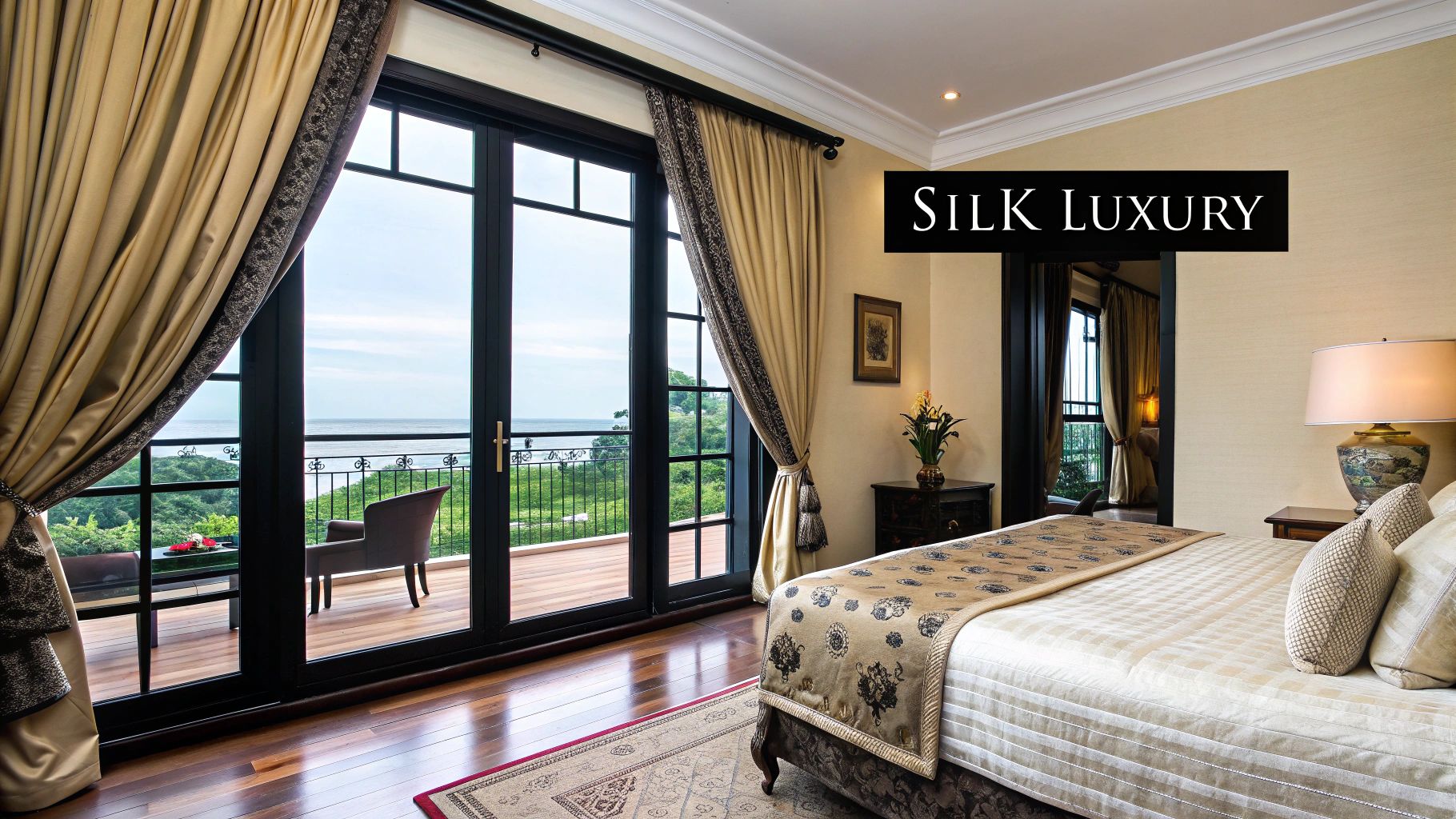
Polyester: The All-Around Performer
Polyester’s greatest strength is its versatility. It can be woven to mimic the look of more expensive fabrics like silk or suede, giving you a high-end aesthetic with low-maintenance care. Most polyester curtains are machine washable, a huge plus for kitchens or children's rooms.
It's worth noting, however, that polyester is less breathable than natural fibers and can sometimes hold onto odors. Even so, its combination of affordability, strength, and style makes it a go-to for many homeowners. Our collection of easy-care living room curtains features tons of beautiful polyester options.
Sheer & Voile: Delicate Strength
When you want to soften the light without completely blocking it, sheer fabrics like voile are the perfect solution. Voile is usually made from polyester or cotton-polyester blends and has a crisp, lightweight feel that drapes beautifully.
Sheer curtains act as a light diffuser, scattering harsh sunlight to create a soft, ambient glow. This makes them perfect for layering with heavier drapes or for use in rooms where you want to maintain a bright, airy atmosphere.
These delicate-looking fabrics are also surprisingly resilient. Because they're synthetic, they resist stretching and fading better than their natural counterparts. For a complete look, consider pairing them with our versatile curtain rods and hardware to achieve that perfect layered effect.
How to Match Curtain Fabric to Each Room's Needs
Choosing the perfect curtain fabric goes beyond color or pattern. Every room has a different job, and the right fabric will help it perform beautifully. A busy living room needs something durable, while a bedroom calls for a fabric that promotes rest. When you think this way, your curtains start making your home work better for you.
Let's look at how different curtain cloth types shine in specific spots around the house.
Living Rooms and High-Traffic Areas
Your living room is the heart of your home. Curtains here need to be tough enough to handle daily opening, closing, and lots of sunlight.
- Best Choices: Polyester blends and cotton are your go-to options. They’re incredibly resilient, easy to clean, and come in countless styles.
- Why They Work: These fabrics won’t fade as quickly as delicate materials and can take the wear and tear of a busy household.
Explore our durable living room curtains, designed to look amazing while standing up to real life.
Bedrooms for Ultimate Rest
The main mission for bedroom curtains is to create a peaceful sanctuary for sleep. That means your top priorities should be light control and privacy.
The right fabric can truly transform your sleep quality by blocking out early morning sun, streetlights, and even some outside noise.
- Best Choices: Velvet and heavyweight linen paired with a blackout lining are the gold standard for their light-blocking and insulating properties.
- Why They Work: These materials help create that dark, quiet cocoon perfect for sleeping. Adding a blackout lining can turn almost any fabric into a light-blocking powerhouse.
Kitchens and Bathrooms
In kitchens and bathrooms, you’re dealing with moisture and potential splatters. The fabric you choose must handle this environment without becoming a magnet for mildew or stains.
- Best Choices: Stick with moisture-resistant synthetics like polyester. They don’t absorb humidity, which is key to preventing mildew.
- Why to Avoid: This is not the place for natural fibers like linen or silk. They can be easily damaged by moisture and are a headache to clean.
Choosing the Right Curtain Fabric by Room
Here’s a quick cheat sheet for dressing your windows:
| Room | Primary Need | Recommended Fabric(s) | Fabric to Avoid |
|---|---|---|---|
| Living Room | Durability & Style | Cotton, Linen, Polyester Blends | Delicate Silk, Sheer Voile |
| Bedroom | Light Control & Privacy | Velvet, Blackout-Lined Fabrics | Unlined, Sheer Fabrics |
| Kitchen | Moisture Resistance & Easy Cleaning | Polyester, Cotton Blends | Silk, Heavy Linen |
| Bathroom | Mildew Resistance & Airflow | Sheer Synthetics, Polyester | Heavy Cotton, Velvet |
| Dining Room | Elegance & Ambiance | Silk, Velvet, High-Quality Linen | Casual Cotton, Polyester |
| Home Office | Glare Reduction & Focus | Room-Darkening Linen, Cotton | Distracting Patterns, Sheers |
Caring for Your Curtains to Make Them Last
Your curtains are an investment in your home's style and comfort. With the right care, you can keep them looking fantastic for years. Different curtain cloth types need their own special attention to stay in top shape.
Ignoring the care tag is a recipe for shrunken, faded, or damaged curtains. The good news is, once you know the basics, caring for most fabrics is surprisingly simple.
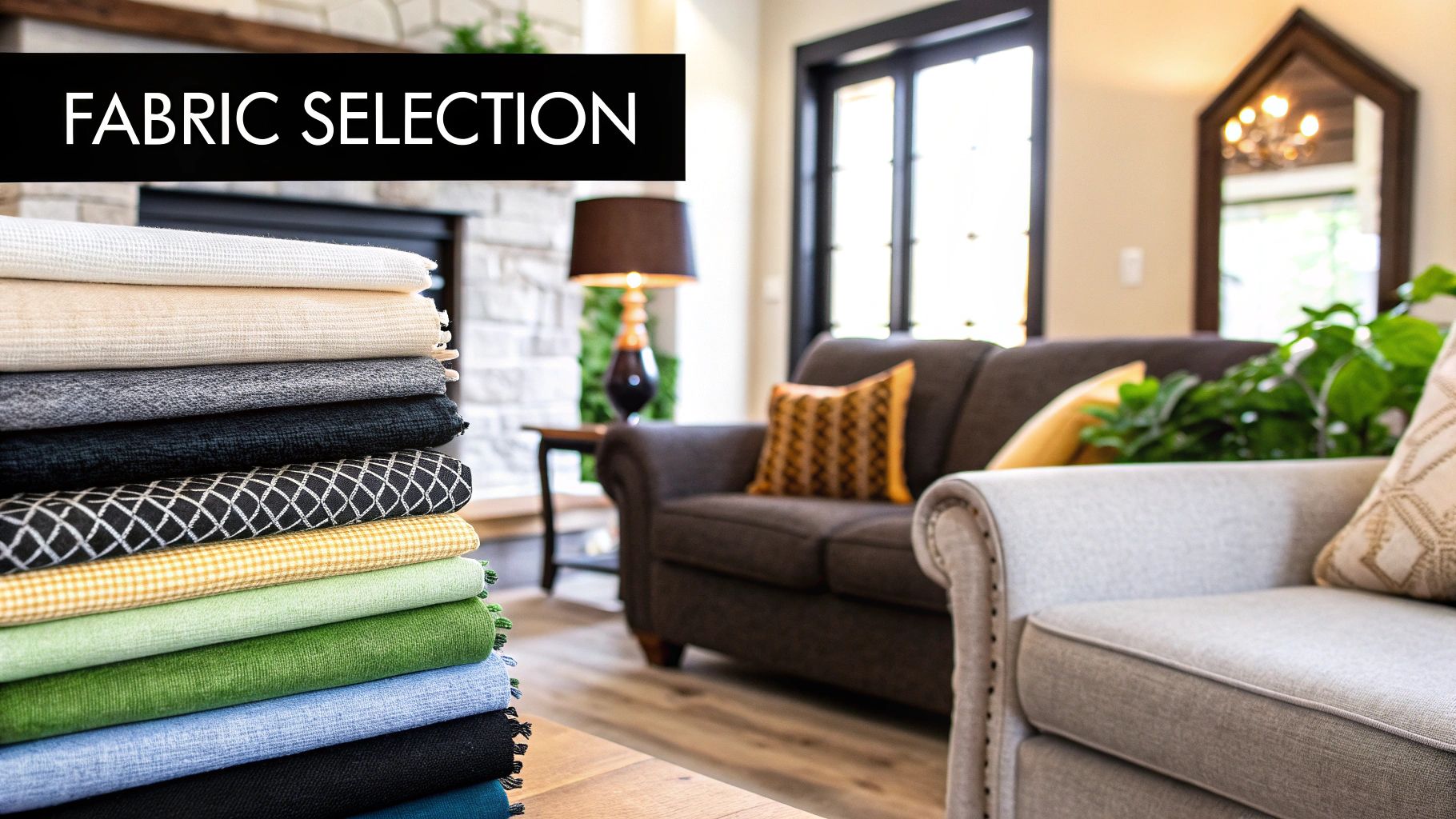
Cleaning Guidelines for Common Fabrics
Before you do anything, always check the manufacturer's care label. That tag is your most reliable guide. That said, here are a few general rules for popular materials.
- Cotton and Polyester: Most can be machine-washed on a gentle cycle with cold water. Tumble dry on low or, even better, hang them to air dry to prevent shrinking.
- Linen: To minimize wrinkles, use a delicate cycle and hang it up to dry the second the cycle finishes. A warm iron or a steamer while the fabric is still damp works wonders.
- Silk and Velvet: These luxurious materials are best left to the professionals. We strongly recommend dry cleaning only to preserve their delicate texture and rich color.
For a more detailed walkthrough, check out our complete guide on how to wash curtains. It's packed with tips to help you get the best results.
Pro Tips for Long-Term Curtain Care
Beyond washing, a few simple habits can make a huge difference. Every so often, vacuum your curtains with a soft brush attachment to remove dust and allergens. For delicate fabrics in a sunny spot, consider adding a protective lining to prevent sun damage.
Frequently Asked Questions
To wrap things up, let's tackle the most common questions about curtain cloth types. Getting these final details sorted will help you feel completely confident in your choice.
What is the most durable type of curtain cloth?
When it comes to durability, polyester is tough to beat. Its synthetic fibers are incredibly resilient, standing up to stretching, shrinking, wrinkles, and—most importantly—sun fading. Sun damage is a huge culprit in weakening fabrics over time. This makes polyester a fantastic choice for high-traffic spots, kids' rooms, or any window that gets blasted with direct sunlight.
Which curtain fabric is best for blocking light?
For maximum light-blocking power, velvet is one of the best choices. Its weave is naturally thick and dense, which stops light in its tracks. However, other fabrics like cotton or polyester can become just as effective when paired with a separate blackout lining. These liners are engineered with an opaque layer that blocks nearly all light, making them perfect for bedrooms where total darkness is the goal.
How do I choose between natural and synthetic curtain fabrics?
The best choice depends on your priorities for the space.
- Choose natural fabrics like cotton and linen if you’re after a breathable, soft feel and a classic, timeless look. They bring a certain warmth and comfort that works beautifully in living rooms and bedrooms.
- Opt for synthetic fabrics like polyester when your main concerns are durability, fade resistance, and easy care. This makes them the go-to choice for kitchens, bathrooms, and sunny areas where performance is just as important as appearance.
At Joey'z Shopping, we believe the right curtains can completely transform your space. Explore our extensive collection of high-quality window treatments to find the perfect style and fabric for your home. Visit us at https://joeyzshopping.com to get started today.
